Coordinators:
Amar Ayyash (USA)
Mars Muusse (Netherlands)
thayers rings
thayers PDF's
thayers 1cy August
thayers 1cy September
thayers 1cy October
thayers 1cy November
thayers 1cy December
thayers 2cy January
thayers 2cy February
thayers 2cy March
thayers 2cy April
thayers 2cy May
thayers 2cy June
thayers 2cy July
thayers 2cy August
thayers 2cy September
thayers 2cy October
thayers 2cy November
thayers 2cy December
thayers 3cy January
thayers 3cy February
thayers 3cy March
thayers 3cy April
thayers 3cy May
thayers 3cy June
thayers 3cy July
thayers 3cy August
thayers 3cy September
thayers 3cy October
thayers 3cy November
thayers 3cy December
thayers sub-ad January
thayers sub-ad February
thayers sub-ad March
thayers sub-ad April
thayers sub-ad May
thayers sub-ad June
thayers sub-ad July
thayers sub-ad August
thayers sub-ad September
thayers sub-ad October
thayers sub-ad November
thayers sub-ad December
thayers ad January
thayers ad February
thayers ad March
thayers ad April
thayers ad May
thayers ad June
thayers ad July
thayers ad August
thayers ad September
thayers ad October
thayers ad November
thayers ad December
|
Thayer's Gull 2cy March (1st cycle)
Below you will find a description of Chapter 36 THAYER'S GULL Larus thayeri, as published in one of the best Gull publication: "Gulls of the Americas" by Steve Howell & Jon Dunn.
"we" in the text below refers to the original authors. If any errors occur in this text, please let me know and mail to marsmuusseatgmaildotcom.
PART 1: IDENTIFICATION SUMMARY & TAXONOMY
PART 2: FIELD IDENTIFICATION SIMILAR SPECIES - ADULT
PART 3: FIELD IDENTIFICATION SIMILAR SPECIES - 1ST CYCLE
PART 4: FIELD IDENTIFICATION SIMILAR SPECIES - 2ND CYCLE
PART 5: RARER SPECIES
PART 6: DESCRIPTION AND MOLT - ADULT & 1ST CYCLE
PART 7: DESCRIPTION AND MOLT - 2ND & 3RD CYCLE
BELOW: PART 5
RARER SPECIES
Adult Cycle.
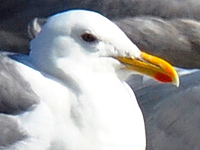 HYBRID GLAUCOUS GULL X VEGA GULL (w. Alaska) larger with longer and stouter bill. Upperpart tone, eye color, orbital ring, and wingtip pattern may resemble Thayer’s Gull, but range of variation poorly known: should be separable by size and structure, especially bill. HYBRID GLAUCOUS GULL X VEGA GULL (w. Alaska) larger with longer and stouter bill. Upperpart tone, eye color, orbital ring, and wingtip pattern may resemble Thayer’s Gull, but range of variation poorly known: should be separable by size and structure, especially bill. |
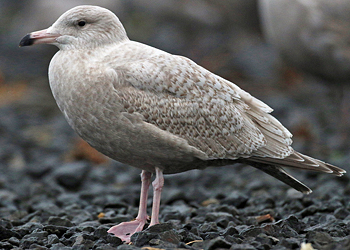 |
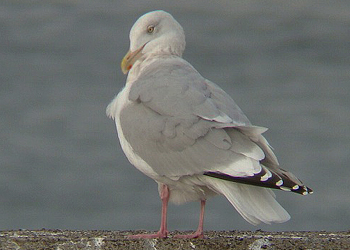 |
| Glaucous x Vega Gull hyperboreus x vegae (?) 1st cycle (1CY), December 26 2013, Hokkaido, Japan (Ian Davies). Bicolored bill points to Glaucous and so is the pattern on coverts and tertials. But the primaries are pale brown. |
Glaucous x Vega Gull hyperboreus x vegae (?) adult, February 02 2010, Choshi, Japan (Gullog). Much like a pale Herring Gull, but with obviously pigmented primaries (much reduced black on underside of P10). Could also be hybrid with American Herring Gull smithsonianus? |
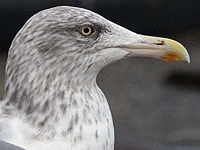 EUROPEAN HERRING GULL (casual e. N. America) typically larger and bulkier with stouter bill; wingtip pattern of some nominate argentatus very similar to Thayer’s but usually with more black on underside of outer primaries. Note size, structure, pale eyes with yellow-orange orbital ring, and upperpart tone (Kodak 4-5 on argenteus, Kodak 5.5-7 on argentatus). EUROPEAN HERRING GULL (casual e. N. America) typically larger and bulkier with stouter bill; wingtip pattern of some nominate argentatus very similar to Thayer’s but usually with more black on underside of outer primaries. Note size, structure, pale eyes with yellow-orange orbital ring, and upperpart tone (Kodak 4-5 on argenteus, Kodak 5.5-7 on argentatus). |
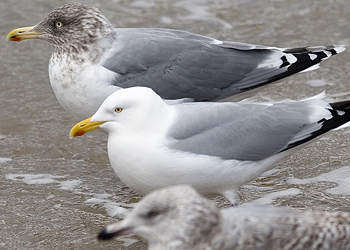 |
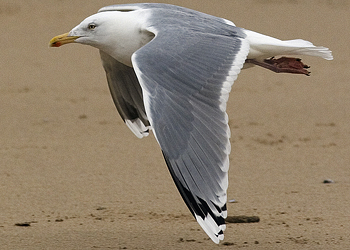 |
Herring Gull (argentatus) adult, February 07 2013, Katwijk, the Netherlands (Mars Muusse). Dark argentatus from Scandinavia, and adult argenteus (argenteus and smithsonianus about equal in grey tone). P10: Mirror merges with tip, P9 with large mirror, no black spot on P5. |
Herring Gull (argentatus) adult, February 14 2012, Noordwijk, the Netherlands (Mars Muusse). Thayeri pattern on P9 and P10, broken band on P7 and only faint black spots on P6. Probably from N Scandinavia. About Kodak 6-7 grey tone. |
First Cycle.
| Also see Yellow-legged Gull (differences given under that species). |
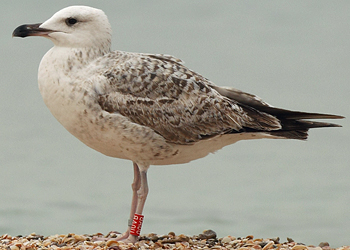 |
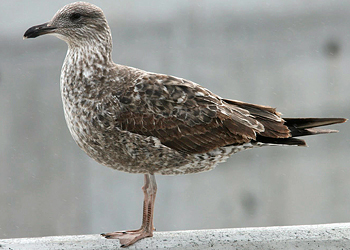 |
Yellow-legged Gull (michahellis) 1st cycle U0AB February 04 2011, Ashdod, Israel (Amir Ben Dov). Banded in Tel Aviv. White-headed. Several MC, LLC and LC replaced for 2nd gen feathers. Juvenile wing-coverts strongly worn. |
Yellow-legged Gull (atlantis) 1st cycle, February 2010, Azores Islands (Peter Alfrey). Atlantis much more mottled. All scapulars are 2nd gen. Also replaced TT2, inner GC, inner MC, inner LLC and about 1/3 of the visible LC. Note replaced body feathers at flanks, side of the neck and head. |
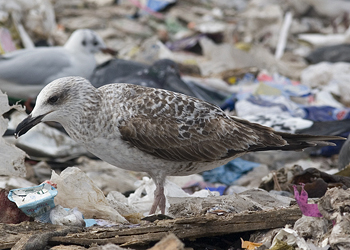 |
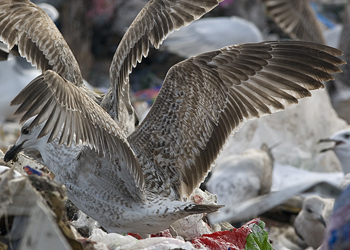 |
| Yellow-legged Gull (michahellis) 1st cycle, February 18-19 2012, Zagreb, Croatia (Mars Muusse). All scapulars replaced. Few wing-coverts replaced for 2nd gen feathers. Head feathers, neck, side of breast and flank replaced for 2nd gen feathers, head still with fine streaking. |
Yellow-legged Gull (michahellis) 1st cycle, February 18-19 2012, Zagreb, Croatia (Mars Muusse). All scapulars replaced. Many inner wing-coverts and upper tertials replaced, outer coverts still juvenile. Flight feathers juvenile. Head feathers, neck, side of breast and flank replaced for 2nd gen feathers, head turning pale again. |
| HYBRID GLAUCOUS GULL X VEGA GULL (w. Alaska) should be separable by size and structure, especially bill; wingtip and tail pattern may resemble Thayer’s, but range of variation poorly known. |
 |
 |
| Glaucous x Vega Gull hyperboreus x vegae (?) 1st cycle (1CY), December 26 2013, Hokkaido, Japan (Ian Davies). Bicolored bill points to Glaucous and so is the pattern on coverts and tertials. But the primaries are pale brown. |
Glaucous x Vega Gull hyperboreus x vegae (?) adult, February 02 2010, Choshi, Japan (Gullog). Much like a pale Herring Gull, but with obviously pigmented primaries (much reduced black on underside of P10). Could also be hybrid with American Herring Gull smithsonianus? |
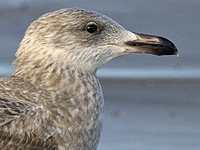 EUROPEAN HERRING GULL averages larger with a stouter bill that generally has more-marked gonydeal expansion; often shows shallower sloping forehead. Inner webs of outer primaries more extensively dark, so that pale inner primary panel on upperwing contrasts more with more solidly dark outer primaries; underside of outer primaries darker (but can be reflectively pale); uppertail coverts and tail base contrastingly white, barred blackish, with contrasting black distal tail band. EUROPEAN HERRING GULL averages larger with a stouter bill that generally has more-marked gonydeal expansion; often shows shallower sloping forehead. Inner webs of outer primaries more extensively dark, so that pale inner primary panel on upperwing contrasts more with more solidly dark outer primaries; underside of outer primaries darker (but can be reflectively pale); uppertail coverts and tail base contrastingly white, barred blackish, with contrasting black distal tail band. |
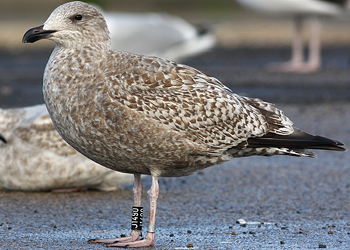 |
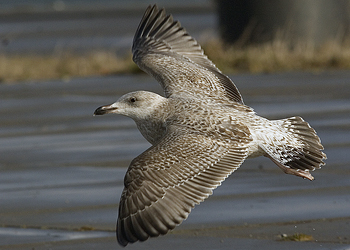
|
Herring Gull (argentatus) 1st cycle J1490 November 27 2011, Boulogne-sur-Mer, France (Jean-Michel Sauvage). Banded in NE Norway (70°N). Most scapulars still juvenile. Argentatus match smithsonianus in jizz and sometimes in underpart texture, still, widely spaced undertail coverts and much proximal white in tail. Also delicate streaking on head and in neck. |
Herring Gull (argentatus) 1st cycle C-730184 December 09 2010, IJmuiden, the Netherlands (Mars Muusse). Banded in N Russia (67°N). Upper scapulars 2nd gen, lower scapulars still juvenile. Largely pale rump, uppertail coverts and bases of rectrices. |
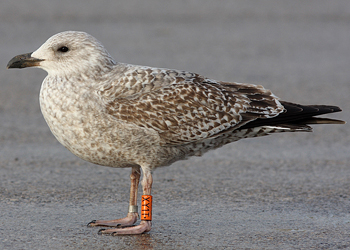 |
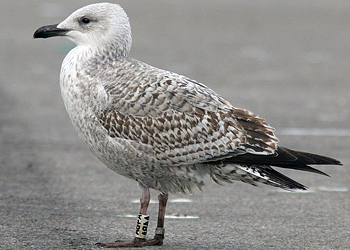 |
Herring Gull (argenteus) 1st cycle XY1T December 03 2012, Boulogne-sur-Mer, France (Jean-Michel Sauvage). Banded in London in winter. All scaps 2nd gen, except rear lower scapulars. Wide spacing on undertail coverts. Pale underparts with delicate streaks. |
Herring Gull (argenteus) 1st cycle A4BA November 24 2006, Boulogne-sur-Mer, France (Mars Muusse). Banded in U.K. All scaps 2nd gen, except rear lower scapulars. Wide spacing on undertail coverts, much proximal white on rectrices, very pale headed. Delicate streaking in neck. |
 |
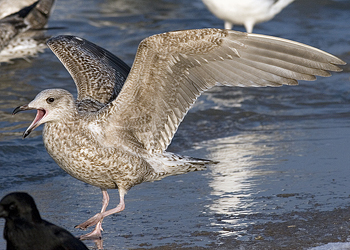 |
| Herring Gull 1st cycle, December 03 2013, Katwijk, the Netherlands (Mars Muusse). Scapulars 2nd gen. Largely pale rump, uppertail coverts and bases of rectrices. |
Herring Gull 1st cycle, January 23 2013, Katwijk, the Netherlands (Mars Muusse). Pale undertail coverts and head. No smooth, washed out texture on underparts, instead much lining and spotting. |
Second Cycle.
Also see European Herring Gull and Yellow-legged Gull (differences given under those taxa).
HYBRID GLAUCOUS GULL X VEGA GULL should be separable by size and structure, especially bill: wingtip and tail pattern may resemble Thayer’s Gull, but range of variation poorly known.
Third Cycle.
European Herring Gull, Yellow-legged Gull, and hybrids differ in much the same ways as do adults (see above and relevant accounts); note Thayer’s Gull size and shape, and two-tone outer primaries.
CONTINUE PART 6 |
 Thayer's Gull 1st cycle (2CY), March 09 2008, Juanita Bay, Kirkland, WA. Picture: Guy Monty. Thayer's Gull 1st cycle (2CY), March 09 2008, Juanita Bay, Kirkland, WA. Picture: Guy Monty. |
 Thayer's Gull (thayeri)
Thayer's Gull (thayeri) Thayer's Gull 1st cycle (2CY), March 09 2008, Juanita Bay, Kirkland, WA. Picture: Guy Monty.
Thayer's Gull 1st cycle (2CY), March 09 2008, Juanita Bay, Kirkland, WA. Picture: Guy Monty. Thayer's Gull 1st cycle (2CY), March 23 2011, Fernhill Wetlands, Forest Grove, Oregon, US. Picture: Greg Gillson.
Thayer's Gull 1st cycle (2CY), March 23 2011, Fernhill Wetlands, Forest Grove, Oregon, US. Picture: Greg Gillson. Thayer's Gull 1st cycle (2CY), March 23 2011, Fernhill Wetlands, Forest Grove, Oregon, US. Picture: Greg Gillson.
Thayer's Gull 1st cycle (2CY), March 23 2011, Fernhill Wetlands, Forest Grove, Oregon, US. Picture: Greg Gillson.















